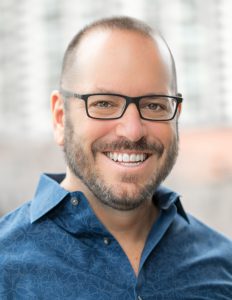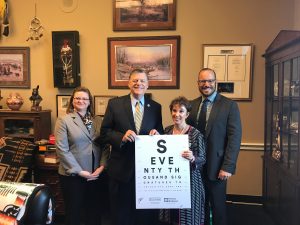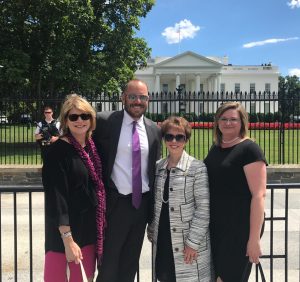



Get new exclusive access to healthcare business reports & breaking news






Interviewee: Jeff Todd, CEO
Healthcare Weekly recently interviewed Jeff Todd, CEO of Prevent Blindness. After 15 years with the organization, Todd assumed his role as CEO in April 2018. He shares his organization’s experiences developing social media strategies, thoughts on emerging technology in healthcare, and the importance of an inclusive discussion on the state of healthcare in the US.
Tell us about Prevent Blindness.


How did you get involved with Prevent Blindness?
JT: Most of my career has been in community service, in both the not-for-profit sector and in state government, having worked for the state of Indiana for 10 years at the beginning of my career. Overall, the main focus of my career has been community health and social services. I’ve been the CEO of Prevent Blindness for about two months now, starting in April of this year [2018]. But I’ve been with Prevent Blindness for the past 15 years overseeing most of our mission-based work, having been hired to expand our national public health presence.
What have been some of the most radical changes that you’ve witnessed, both in the digital space and in how your company has adopted digital technologies?
JT: Certainly for us, advances in social media over the last 15 years have had a tremendous impact. For a relatively small non-profit that aims to have a national reach with a limited budget, what we’re able to achieve through Facebook and Twitter is so much more significant than ever before.
We’ve also noticed a major shift as an organization in the way we communicate with people. We have a call center for people with questions or concerns about eye health. Back when I started, 15 years ago, the vast majority of inquiries would come via telephone — now they really come through our website. So that’s certainly helped us more efficiently manage this part of our work.
Prevent Blindness has an active event calendar. Specifically, you host the Focus on Eye Health National Summit, as well as the Focus Initiative. Can you talk about the challenges, opportunities and any successes of hosting an such an event?
JT: Well, we’re heading into our seventh year of hosting this national summit in Washington, DC, which typically has about 250 attendees discussing vision and public health. Early on, we felt there was a need to expand its reach, so we now host a live web feed of the summit so folks from across the country can tap into the content remotely either live or after the fact to view recordings of the various speakers.
Additionally, we’re still exploring ways that we can utilize LinkedIn to continue to expand our social media presence; in this case, specifically to establish an ongoing dialogue around vision and public health through our Focus Initiative. We’re currently re-evaluating how we utilize this digital forum in a way that maximizes its potential.
Can you speak more generally about the role social media plays in your overall strategy? Can you share any tips for other healthcare executives who are considering social media as a strategy for connecting with their community?


JT: What we have recognized is that we really need to target specific users personally through our social media strategy. For example, we’ve had a Twitter account for some time (@PBA_savingsight), putting out general information about eye health or our organization, but we recently found a need for a second account. Because we do a lot of work in Washington related to public policy and advocacy, and much of Washington advocacy revolves around Twitter, we created a separate Twitter account (@EyesOnCapHill) that’s specifically aimed at serving our advocacy needs. We use this account to engage in dialogue around what’s going on in the federal government space and to keep our community updated on any potential impact to eye health due to federal action. By doing so, we’ve been able to have more impact amongst those looking to be advocates for eye health versus consumers of information.
My recommendation for other executives is to be very cognizant of your target audience, as well as the roles your various social media channels play.
When you have diverse audiences, like Prevent Blindness does, what’s your strategy to make sure that the content you share on Twitter, Facebook and LinkedIn encourages engagement?
JT: Part of our strategy relies on having staff who work in the areas we’re trying to impact guiding our social media strategy. Our advocacy Twitter account is managed by our Director of Government Affairs in Washington, D.C. She’s continually up-to-date on what’s going on and sharing content that appeals to our advocacy audience, whereas our Director of Marketing manages our traditional organizational Twitter account and Facebook page, and our Director of Public Health coordinates our LinkedIn channel that targets the public health community.
This strategy has been really helpful for managing our social content because we have staff who are actively engaged in the work sharing content directly with our various audiences.
You mentioned your Focus on Eye Health National Summit in Washington D.C. this July, can you share some of the topics that will be covered during the summit?
JT: Our keynote presenter is Dr. Lily Peng from Google, and she’ll be talking about the growing field of Artificial Intelligence as it relates to eye health and how we can tap into artificial intelligence in a way that allows us to remotely detect vision problems.


For example, the technology current exists to utilize retinal imaging cameras to take a
picture of the back of the eye which can be read remotely by an ophthalmologist across the state or the country. They can then determine if a potential vision problem exists and recommend a course of action or care to the local physician. However, using
artificial intelligence and computer-generated information gathered from reading multiple images, the pictures can be evaluated in the same way that an ophthalmologist would and results and treatment plans can be automatically sent to a PCP.
Additionally, at this year’s summit, we are celebrating the 50th anniversary of the National Eye Institute. Certainly advancing technology has been a part of this institute’s long history. One topic we will discuss is how optical coherence tomography (OCT) has changed eye care delivery. This is a technology that uses coherent light to capture two- and three-dimensional images of the retina, drastically enhancing the doctor’s ability to understand what is going on in the patient’s eye.
What do you think are some of the most critical technologies that will ultimately reshape healthcare, the field, in the next five to 10 years?
JT: Well, as previously discussed, various ways of providing eye care through telemedicine and digital channels will continue to shape how we deliver care. Whether it’s in eye care or general health, we need to embrace these while also staying cautious of what their implementation means.
For example, it might be great for a person to be able to perform a full eye exam from their iPhone and potentially be able to share those screening results with an eye doctor. But how do we ensure they actually take that next step of seeing the doctor and entering into care?
And as it relates to artificial intelligence, how can we tap into that technology while still protecting the privacy rights of patients across the country.
While these advances are interesting to consider and could change how eye care is delivered, we need to be careful to ensure that we look out for the best interests of the patient. While such technologies may improve access to eye care, we need to be certain that they don’t hinder the quality of the care provided. The personal role of eye care providers – ophthalmologists and optometrists – will always be essential to eye care, regardless of such advances.
What keeps you up at night as a CEO of a healthcare organization?
JT: Eye health is not something people generally think of as part of their regular health care, so making sure that when we’re talking about the broad topic of healthcare, vision is a part of that conversation. We need to continually remind people that eye health is important.
Eye health is the fifth largest chronic health condition impacting our country. But we don’t hear about it often, largely because people aren’t dying from vision problems or vision disorders. However, these conditions are having major impacts on quality of life. And so, while we’re not hearing about eye health problems to the degree that we’re hearing about diabetes, cancer or heart disease — and we never will — we need to continue to raise the profile of eye health and make sure that all aspects of healthcare are being addressed.
As it relates to general health, the thing that keeps me up at night is making sure that our nation’s public health system and policies are supporting improved access to healthcare for all. I think one of the challenges we’re seeing with this administration and, to a degree, even the one prior, is that we’re having these ongoing debates around healthcare that are being pulled back and forth, and there doesn’t seem to be a general consensus that we want to move things forward in a collaborative way. At some point, we have to come together and say we’re not gonna pull it to the left, we’re not gonna pull it to the right, we’re going to move things forward.
Can you talk about your overall digital strategy, why your company is leveraging digital so heavily, and particularly, any advice that you may have for executives, especially those that don’t quite necessarily think they need a digital strategy in the healthcare space.
JT: What we recognized, as a relatively small organization (we have a four million dollar budget and about 20 staff) is that we are limited by our resources, but we are able to invest our time and our strategic thinking by capitalizing on the availability of social media. And to do so relatively quickly.
For example, when we decided strategically to invest time in a second Twitter account, our Director of Government Affairs was able to jump on that and start a new account overnight, and it’s just grown from there.
And as I’m continually reminded by staff, we need to understand the platforms that we’re using and how best to use them and what they’re for. You’re not going to see us putting huge reports or studies on our Facebook page. But you may see more of that on our LinkedIn page, which is targeted to professionals. So it’s really about making sure that we’re utilizing the platforms in the way they’re intended.
Can you tell us one thing about your leadership style you feel directly attributes to the success of your organization?
JT: As with most leaders, I suspect my style is ever evolving. But what I do try to do is realize that I have a great team that knows what they are doing, and each of them have their own individual styles.
As a leader, it’s important for me to be able to interact with individuals on the team in ways that work for them. My interactions with one may be very different than those with another. They shouldn’t have to adapt their style to suit mine. Hopefully, my role is to help bring the various approaches together in a way that forms a successful, cohesive and productive team.
Can you share a must-read recommendation for healthcare executives?
JT: I recently used a quote from Susan Sontag’s “Illness as Metaphor” in a presentation. She wrote: “Everyone who is born holds dual citizenship: in the kingdom of the well and the kingdom of the sick. Although we all prefer to use the good passport, sooner or later each of us is obliged, at least for a spell, to identify ourselves as citizens of that other place.”
The book, and this quote, which is largely about removing stigma from illness, remind us that healthcare is something that impacts us all.
This interview has been edited and condensed.